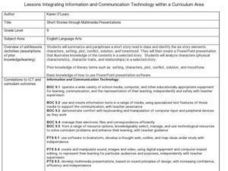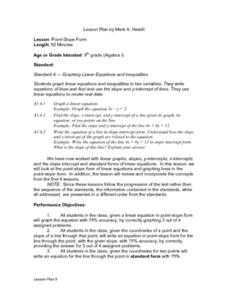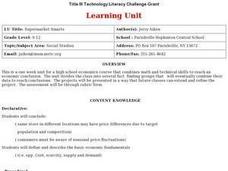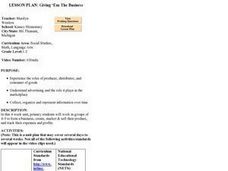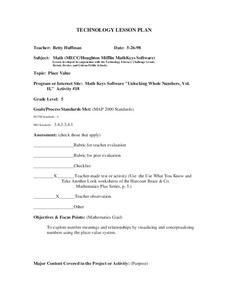Curated OER
Website Scavenger Hunt
Students use the internet to complete a species scavenger hunt. In groups, they answer questions given to them about sea lions, rockfish and killer whales. As a class, they identify any questions they have and discuss the role...
Curated OER
A Picture is Worth a Thousand Words
Young scholars examine the differences between the Euro coins and bills. As a class, they discuss importance of the images on the money and use the internet to research why they were selected. In groups, they design new bills with...
Curated OER
Lucky 7s
This helpful lesson explores the probability in tossing a coin and throwing dice. Specifically, it looks at the probability of getting numbers that are significant to the game of craps, assuming that once the math is understood, most...
Curated OER
Short Stories Through Multimedia Presentations
Ninth graders summarize and paraphrase a short story read in class. They identify the six story elements of character, setting, plot, conflict, solution, and tone/mood. Students create a PowePoint presentation that illustrates the...
Curated OER
The 3R's: Rights, Rules, and Responsibilities
Eighth graders complete seven work stations that highlight math activities while they focus on the rules for Internet use and classroom rules for working in cooperative groups. After completing the activities, they complete a self-...
Curated OER
Reading the Election Results
Young scholars read a chart that shows results of the 1996 presidential election. They answer teacher created questions about the chart.
Curated OER
Animal Encyclopedia Search
Learners use an online encyclopedia to gather information about animals. They identify habits of ten animals they find interesting. They share their information with the class.
Curated OER
To Be or Not To Be: A Career Awareness Project
Learners explore the Six Michigan Career Pathway Clusters and possible careers for their future. They research various careers and career paths. Students create a PowerPoint presentation based on the Career or Career Cluster of their...
Curated OER
Exploring Multiplication Functions
Fourth graders investigate the terms "factor" and "product." In this mathematics lesson, 4th graders practice solving problems to find the products and factors present in different algebraic expressions.
Curated OER
Point-Slope Form
Ninth graders explore the point-slope form of linear equations and graph lines in the point-slope form. After completing the point-slope equation, they identify the slope of a line through a particular point. Students explain the...
Curated OER
Thanksgiving Then and Now
Young scholars create a Venn diagram to compare the Pilgrim's "First Thanksgiving" with today's Thanksgiving celebration. They use one type of graphic organizer, a Venn diagram, talk and read about the Thanksgiving celebration of 1621 at...
Curated OER
Folktales around the World (Middle, Reading/Writing)
Students analyze, synthesize, and use the elements of various US cultural folk tales to describe the elements of fiction in general and in folk tales specifically.
Curated OER
Supermarket Smarts
Students examine how a consumer can make informed choices. They visit stores with a prepared shopping list, record the prices on a spreadsheet, create graphs, and create a Powerpoint presentation comparing the total cost of stores and a...
Curated OER
Designing Another Juilliard
Students investigate the vision and history of the Juilliard School. They develop a personal mission statement, watch a video, conduct Internet research, and create a PowerPoint presentation about a fictional school that also promotes...
Curated OER
Cancer in My Classroom I
Student explore cancer, its causes, and various types. Learners research compare/contrast a health cell to a cancer cell. They compare treatments available for childhood cancers.
Curated OER
Giving Them the Business
Students work in small groups of 4-5 students to form a business, create, market and sell their product, and track their expenses and profits. They experience the roles of the producer, distributor, and consumer of goods.
Curated OER
Finding Area
Fourth graders explore how to find the area of a rectangular object. As a class, they discuss definition of area and strategies for finding area. The teacher models finding the area of an object by counting squares. Students observe...
Curated OER
Identifying Clouds
Eighth graders research and present to the class information about cloud categories. They observe clouds and describe the characteristics of their cloud observations. They take a cloud identification quiz.
Curated OER
Website Design Using HTML Code
Students participate in an activity to discover vocabulary necessary for website design. They observe a demonstration of website design using HTML code and then design two simple web pages with specific criteria. The final project allows...
Curated OER
Amphibians-Frog Dissection
Pupils compare the anatomy of a fish to an amphibian and that of an amphibian (frog) to a human. They complete a virtual frog dissection to gain some experience prior to the real dissection.
Curated OER
A Simple Machines Activity
Fourth graders observe examples of simple machines found in the school, playground, and work environment. In this simple machines instructional activity, 4th graders review simple machines by viewing three web sites. Students tour the...
Curated OER
Place Value
Fifth graders explore number meanings and their relationship. Using place value clues and base-ten blocks, 5th graders build a models of numbers and determine their value. To reinforce number relationship, students participate in a...
Curated OER
The Environments of Big Sur:Which Do We Protect?
Students examine the California environments. In this environmental lesson, students examine the various ecosystems of California, creating a presentation on how these environments impact Big Sur. They write a paper defending their point...
Curated OER
Watersheds, Watersheds Everywhere
Students identify the watershed in which their school is located. They use maps to locate their homes and school. They define and use the correct vocabulary.



